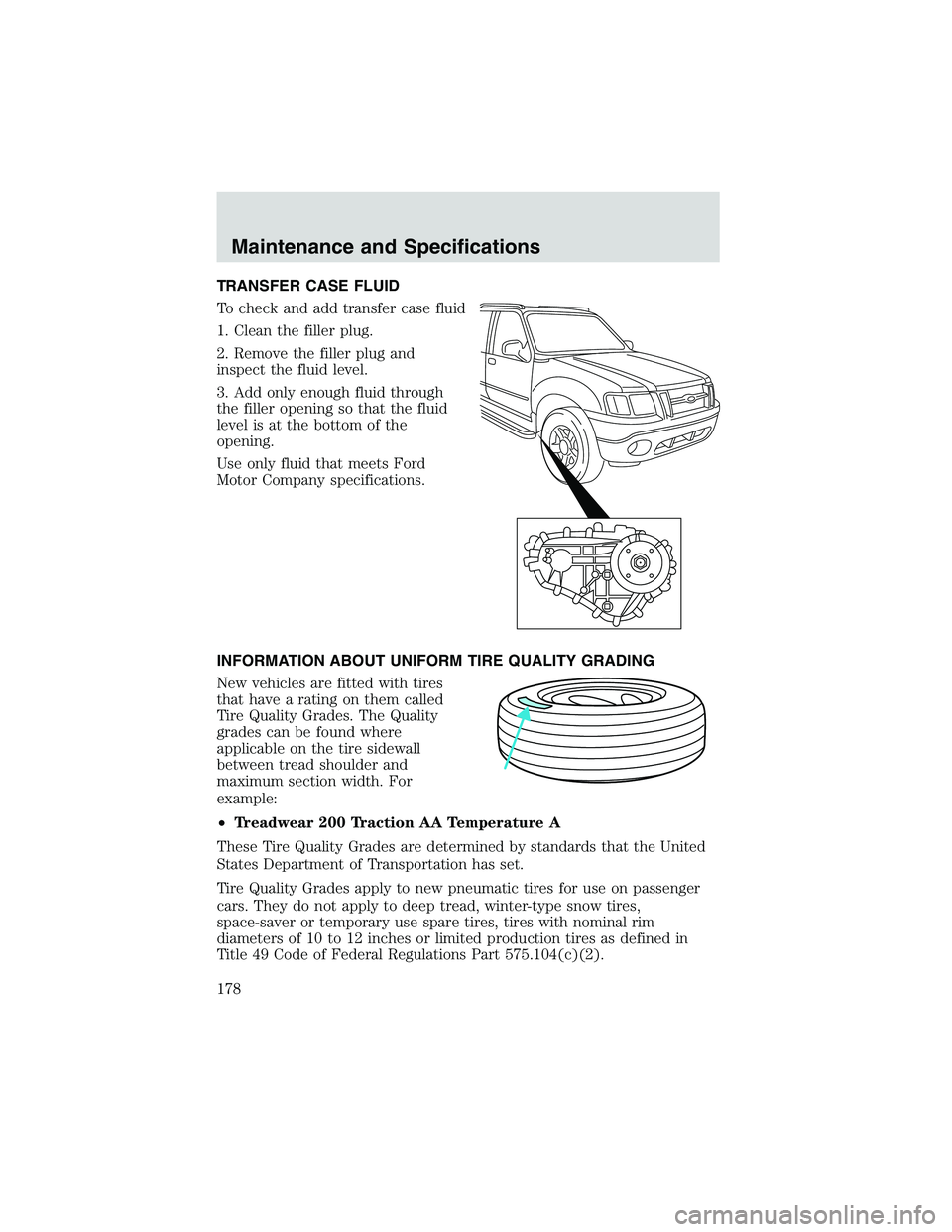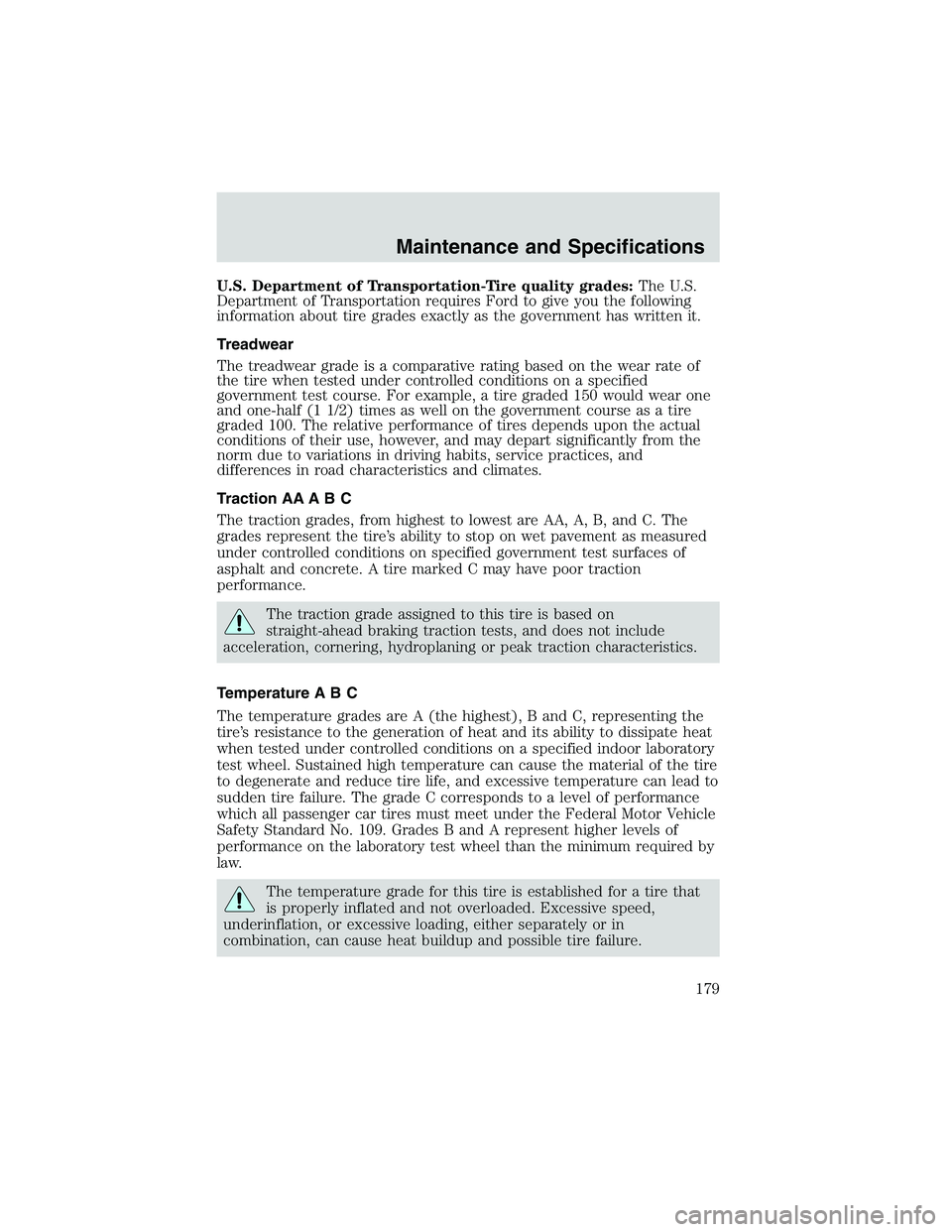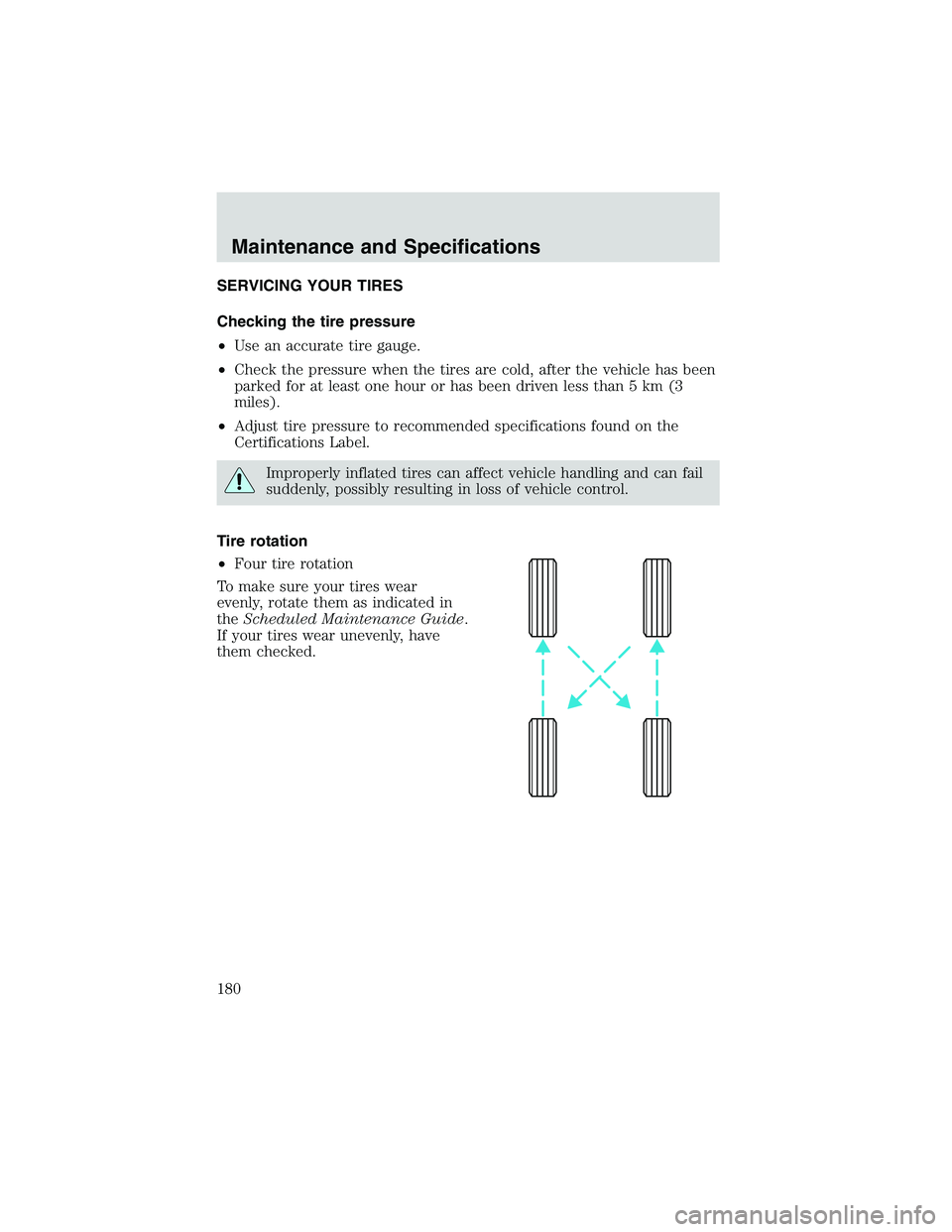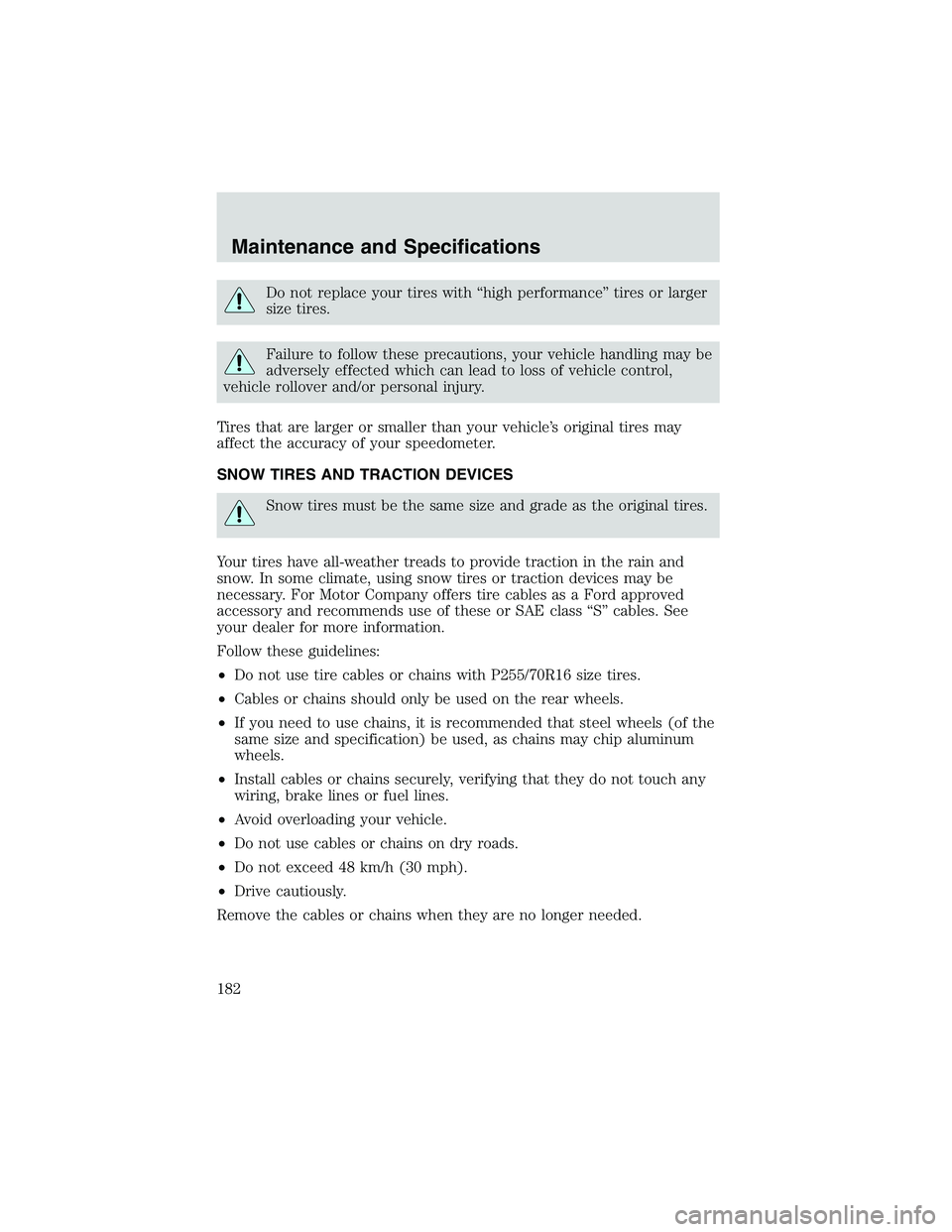2002 FORD EXPLORER SPORT TRAC tires
[x] Cancel search: tiresPage 178 of 200

TRANSFER CASE FLUID
To check and add transfer case fluid
1. Clean the filler plug.
2. Remove the filler plug and
inspect the fluid level.
3. Add only enough fluid through
the filler opening so that the fluid
level is at the bottom of the
opening.
Use only fluid that meets Ford
Motor Company specifications.
INFORMATION ABOUT UNIFORM TIRE QUALITY GRADING
New vehicles are fitted with tires
that have a rating on them called
Tire Quality Grades. The Quality
grades can be found where
applicable on the tire sidewall
between tread shoulder and
maximum section width. For
example:
•Treadwear 200 Traction AA Temperature A
These Tire Quality Grades are determined by standards that the United
States Department of Transportation has set.
Tire Quality Grades apply to new pneumatic tires for use on passenger
cars. They do not apply to deep tread, winter-type snow tires,
space-saver or temporary use spare tires, tires with nominal rim
diameters of 10 to 12 inches or limited production tires as defined in
Title 49 Code of Federal Regulations Part 575.104(c)(2).
Maintenance and Specifications
178
Page 179 of 200

U.S. Department of Transportation-Tire quality grades:The U.S.
Department of Transportation requires Ford to give you the following
information about tire grades exactly as the government has written it.
Treadwear
The treadwear grade is a comparative rating based on the wear rate of
the tire when tested under controlled conditions on a specified
government test course. For example, a tire graded 150 would wear one
and one-half (1 1/2) times as well on the government course as a tire
graded 100. The relative performance of tires depends upon the actual
conditions of their use, however, and may depart significantly from the
norm due to variations in driving habits, service practices, and
differences in road characteristics and climates.
Traction AA A B C
The traction grades, from highest to lowest are AA, A, B, and C. The
grades represent the tire’s ability to stop on wet pavement as measured
under controlled conditions on specified government test surfaces of
asphalt and concrete. A tire marked C may have poor traction
performance.
The traction grade assigned to this tire is based on
straight-ahead braking traction tests, and does not include
acceleration, cornering, hydroplaning or peak traction characteristics.
Temperature A B C
The temperature grades are A (the highest), B and C, representing the
tire’s resistance to the generation of heat and its ability to dissipate heat
when tested under controlled conditions on a specified indoor laboratory
test wheel. Sustained high temperature can cause the material of the tire
to degenerate and reduce tire life, and excessive temperature can lead to
sudden tire failure. The grade C corresponds to a level of performance
which all passenger car tires must meet under the Federal Motor Vehicle
Safety Standard No. 109. Grades B and A represent higher levels of
performance on the laboratory test wheel than the minimum required by
law.
The temperature grade for this tire is established for a tire that
is properly inflated and not overloaded. Excessive speed,
underinflation, or excessive loading, either separately or in
combination, can cause heat buildup and possible tire failure.
Maintenance and Specifications
179
Page 180 of 200

SERVICING YOUR TIRES
Checking the tire pressure
•Use an accurate tire gauge.
•Check the pressure when the tires are cold, after the vehicle has been
parked for at least one hour or has been driven less than 5 km (3
miles).
•Adjust tire pressure to recommended specifications found on the
Certifications Label.
Improperly inflated tires can affect vehicle handling and can fail
suddenly, possibly resulting in loss of vehicle control.
Tire rotation
•Four tire rotation
To make sure your tires wear
evenly, rotate them as indicated in
theScheduled Maintenance Guide.
If your tires wear unevenly, have
them checked.
Maintenance and Specifications
180
Page 181 of 200

•Five tire rotation
To make sure your tires wear
evenly, rotate them as indicated in
theScheduled Maintenance Guide.
If your tires wear unevenly, have
them checked.
Replacing tires
Replace the tires when the wear
band is visible. Due to exposure to
the elements and exhaust you
should replace the spare tire when
you replace the other tires.
Never mix radial bias-belted tires, or bias-type tires. Use only the
tire sizes that are listed on the Certification Label. Make sure
that all tires are the same size, speed rating, and load carrying
capacity. Use only the tire combinations recommended on the label. If
you do not follow these precautions, your vehicle handling may be
effected which can lead to loss of vehicle control, vehicle rollover
and/or personal injury.
Make sure that all replacement tires are of the same size, type,
load-carrying capacity and tread design as originally offered by
Ford.
Maintenance and Specifications
181
Page 182 of 200

Do not replace your tires with“high performance”tires or larger
size tires.
Failure to follow these precautions, your vehicle handling may be
adversely effected which can lead to loss of vehicle control,
vehicle rollover and/or personal injury.
Tires that are larger or smaller than your vehicle’s original tires may
affect the accuracy of your speedometer.
SNOW TIRES AND TRACTION DEVICES
Snow tires must be the same size and grade as the original tires.
Your tires have all-weather treads to provide traction in the rain and
snow. In some climate, using snow tires or traction devices may be
necessary. For Motor Company offers tire cables as a Ford approved
accessory and recommends use of these or SAE class“S”cables. See
your dealer for more information.
Follow these guidelines:
•Do not use tire cables or chains with P255/70R16 size tires.
•Cables or chains should only be used on the rear wheels.
•If you need to use chains, it is recommended that steel wheels (of the
same size and specification) be used, as chains may chip aluminum
wheels.
•Install cables or chains securely, verifying that they do not touch any
wiring, brake lines or fuel lines.
•Avoid overloading your vehicle.
•Do not use cables or chains on dry roads.
•Do not exceed 48 km/h (30 mph).
•Drive cautiously.
Remove the cables or chains when they are no longer needed.
Maintenance and Specifications
182
Page 188 of 200

3Traction-Lok rear axles are filled with Motorcraft SAE 75W-140 High
Performance Synthetic Rear Axle Lubricant, part number F1TZ-19780-B,
Ford specification WSL-M2C192-A.
4Add 118 ml (4 oz) of Additive Friction Modifier C8AZ-19B546-A or
equivalent meeting Ford specification EST-M2C118–A to Traction-Lok
rear axles whenever the axle has been serviced.
ENGINE DATA
Engine 4.0L SOHC V6 engine
Cubic inches 245
Required fuel 87 octane
Firing order 1-4-2-5-3-6
Spark plug gap 1.3-1.4 mm (0.052-0.056 inch)
Ignition system EDIS
Compression ratio 9.7:1
VEHICLE DIMENSIONS
Dimensions 4-Door mm (in.)
(1) Overall length 5 230 (205.9)
(2) Overall width 1 823 (71.8)
(3) Vehicle height/ Maximum
height*1 776 (69.9)/1 794 (70.6)*
(4) Wheelbase 3 198 (125.9)
(5) Front track /Rear track 1 486 (58.5)/1 480 (58.3)
*Denotes a 4x4 vehicle with 16”tires
Maintenance and Specifications
188
Page 197 of 200

S
Safety belts (see Safety
restraints) ..............................73–77
Safety defects, reporting ..........152
Safety restraints ....................73–77
belt minder ...............................79
cleaning the safety belts ..........82
extension assembly ..................82
for adults .............................74–76
for children .........................87–88
lap belt ......................................78
warning light and chime ..........78
Safety seats for children ............91
Seat belts (see Safety
restraints) ....................................73
Seats ............................................68
child safety seats ......................91
Spare tire (see Changing the
Tire) ...........................................135
Spark plugs,
specifications .....................183, 188
Specification chart,
lubricants ...........................186, 188
Speed control ..............................49
Starting your vehicle ..99–100, 102
Steering wheel
tilting .........................................42
T
Tailgate ..................................54–55
Tires ...................................178–179
changing ..................................135tire grades ...............................179
treadwear ................................179
Tonneau cover .............................57
Towing .......................................118
recreational towing .................123
trailer towing ..........................118
Traction-lok rear axle ...............105
Transmission .............................106
fluid, checking and adding
(manual) .................................177
fluid, refill capacities ..............183
lubricant specifications ..186, 188
manual operation ....................109
Trunk ...........................................59
Turn signal ..................................36
V
Vehicle dimensions ...................188
Vehicle Identification Number
(VIN) ..........................................190
Vehicle loading ..........................116
camper bodies ........................123
Ventilating your vehicle ...........103
W
Warning lights (see Lights) .........8
Water, Driving through .............116
Windows
power .........................................45
power down back window .......46
Windshield washer fluid and
wipers ..........................................41
replacing wiper blades .............41
Index
197